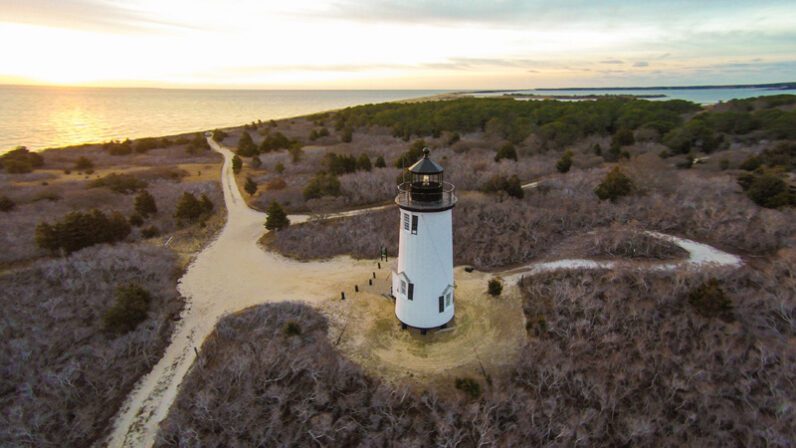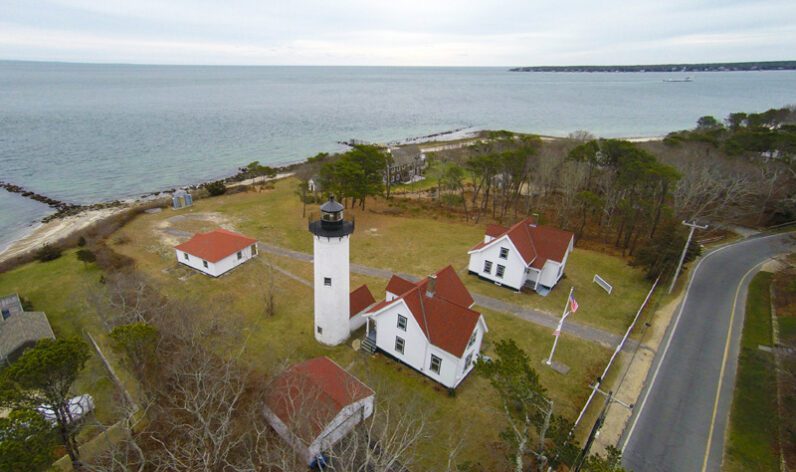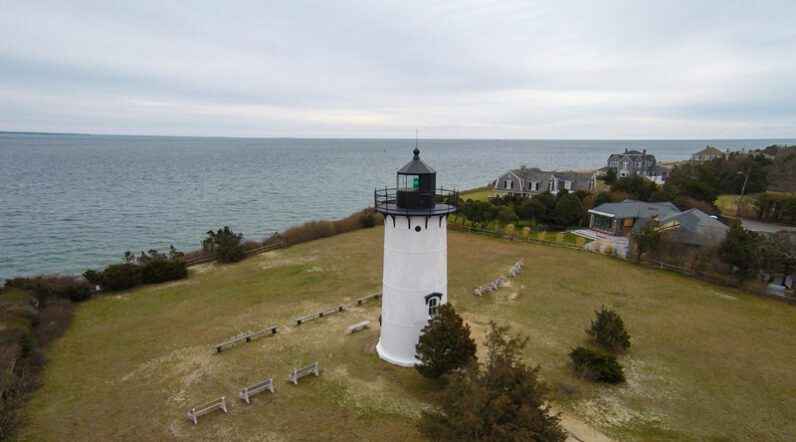Lighthouses are symbols of hope, home, and safety. Without them, seafaring exploration and trade would have been impossible. Martha’s Vineyard is home to five lighthouses, which overlook the Vineyard Sound and Nantucket Sound, as well the entrance of Edgartown Harbor and Cape Poge. These historical gems are well worth checking out while you’re exploring the Island.
Gay Head Lighthouse was one of the first lighthouses established in the newly independent United States and was authorized to be erected by President John Adams. “Charles Vanderhoop, a member of the Wampanoag tribe, born and raised in the town of Gay Head (now Aquinnah), was the first Indigenous keeper in the history of American lighthouses from 1920 to 1933,” Bowdoin Van Riper, research librarian at the Martha’s Vineyard Museum, says. Another interesting fact about this 400-ton beacon is that due to erosion, in 2015, it was lifted off its foundation and moved inland to its current location.
In 1801, the second lighthouse to be built on the Island, Cape Poge Lighthouse, was sanctioned by President Jefferson. “Cape Poge Lighthouse was (and is) the most isolated of all the Vineyard lighthouses,” Van Riper says. “Even today, it can be reached only by water or by a sandy road usable only by four-wheel drive. Cape Poge Lighthouse has been moved back from the cliff edge four times.” (Fun aside: The Cape Poge Lighthouse can be seen in the final two shots in the film “Jaws,” as Roy Scheider and Richard Dreyfuss swim back to shore.)


West Chop Lighthouse was the third lighthouse built on the Island, in 1817. “It was a popular stopover point in the days when sailing ships and steam tugs moved heavy freight up and down the East Coast,” says Van Riper. “By 1891, West Chop had become a posh summer resort area, and the current tower was built to raise the light above the two- and three-story summerhouses around it. West Chop Lighthouse is the only one that still has the keeper’s and an assistant keeper’s houses intact.”
In 1828, the Edgartown Harbor Lighthouse was built, making it the fourth lighthouse on the Island. “Edgartown Outer Harbor is shaped like a funnel, with Chappaquiddick to the east and a large area of shoals called ‘the Flats’ to the west,” Van Riper continues. “The lighthouse provided a reference point for vessels entering Edgartown Harbor, so they could stay in the center of the funnel as they worked their way in. Beginning in 1830, a wooden footbridge linked it to the land. According to legend, it became known as the ‘Bridge of Sighs,’ because sailors took their wives and girlfriends there the night before they set sail.”


The East Chop Lighthouse, built in 1879, is the fifth and last-built Island lighthouse. “Captain Silas Daggett, a Vineyarder who made his living sailing cargo schooners along the East Coast, felt that Vineyard Haven Harbor was important enough as a port that both its headlands should be marked by lighthouses. His petitions to the Lighthouse Board went nowhere, so he took up a collection among his fellow captains and shipowners, built a wooden lighthouse on the bluffs at East Chop in 1869, and hired a retired sailor to look after it.” East Chop was also the first Island lighthouse to be electrified and automated, in 1927.
To check out these intriguing lighthouses, here’s the scoop:
- Edgartown Lighthouse is open, weather permitting, July and August, seven days a week, from 10 am to 4 pm.
- Gay Head Lighthouse is worth the drive. The views of the cliffs, the ocean, and the Elizabeth Islands are awe-inspiring. Hours are July through Labor Day Weekend, Monday to Sunday 10 to 4 pm, and Thursdays 10 am to sunset. Hours may be impacted by staff availability and weather. (Also, be sure to check out the Aquinnah Cultural Center, a museum of Wampanoag history and culture, while there.)
- Cape Poge Lighthouse, which is accessible only by four-wheel-drive vehicle or a guided tour with the Trustees of Reservations, is closed. However, they may be doing Natural History Tours which, depending on where protected shorebirds are nesting, will go to the Great Point Lighthouse. Please check the Trustees website, thetrustees.org, to get updates.
- West Chop Lighthouse is closed to the public, but ferries entering and leaving Vineyard Haven have a wonderful view from the water. To see it from the land you can walk, bike, or drive along Main Street from downtown Vineyard Haven.
- East Chop Lighthouse is open Sundays for sunsets from mid-June through mid-September. Martha’s Vineyard Museum (MVM) maintains a list of visiting hours at mvmuseum.org.
If you’d like to take a deeper dive into the Island’s lighthouses, head over to the museum to check out their collection. Visit their library and peruse books on the history of lighthouses, keepers’ logs, and mid-19th-century documents about the operation of Island lighthouses and lightships. For more info, see mvmuseum.org.
You can also get the skinny from local authors, like Seamond Ponsart Roberts, whose book “Everyday Heroes” is a memoir of growing up as a lighthouse keeper’s daughter in the late 1930s and 1940s. Roberts’ book is available at Edgartown Books. Island photographer Alison Shaw’s “To the Harbor Light’” captures the lighthouses of Martha’s Vineyard, Nantucket, and Cape Cod, and is available at Bunch of Grapes bookstore in Vineyard Haven and at her studio in Oak Bluffs. Also, A. Bowdoin Van Riper’s “Martha’s Vineyard Lighthouses” is a definitive history of the subject, illustrated with period photos, and is available at the MVM library.
Intrigued? Follow the light!
